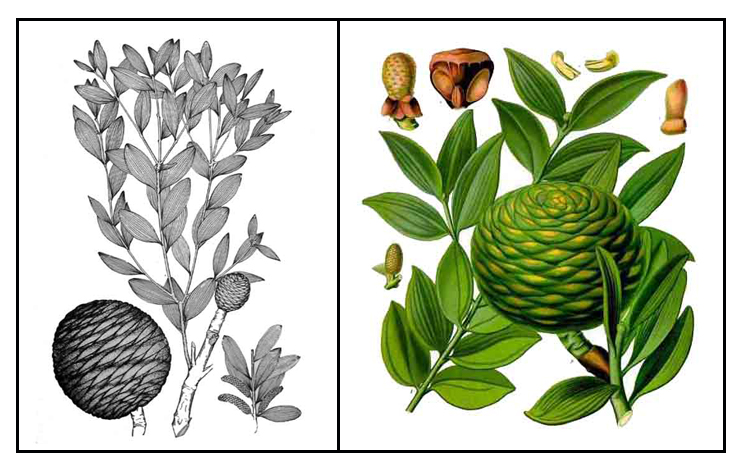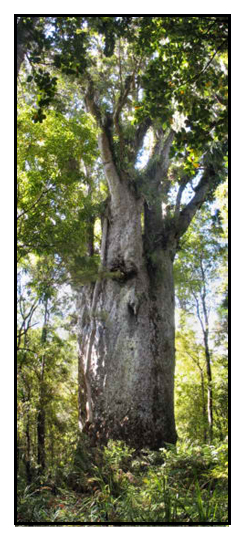
Gen info
- Agathis, commonly known as kauri or dammara, is a genus of evergreen coniferous trees, native to Australasia and Southeast Asia. It is one of three extant genera in the family Araucariaceae, along with Wollemia and Araucaria. (24)
- Various species of kauri yield diverse resins such as kauri gum. (24)
-
The genus name Agathis derives from the Greek word agathis meaning "a ball of thread", referring to the catkin on female trees.
- Agathis dammara has traveled a taxonomic journey: When first discovered (Lambert 1803), it was placed in the genus Pinus, then to the fir Abies (Poir 1817), to the genus Dammara, where it was first recognized as part of Agathis (1807) and listed as Agathis loranthifolia, later with species names beccarii, celebica, and macrostachys, finally settling on dammara. (25)
 Botany Botany
• Almaciga is a large tree with a pyramidal crown and whorled branches, growing
to a height of 50 to 60 meters, the trunk up to 3 meters in diameter with
a smooth and graying bark exuding resin. Leaves are simple, opposite or nearly so, entire
and leathery, oblong-lanceolate to linear-lanceolate, obtuse, 3 to 9.5 centimeters long, 1 to 2.5 centimeters
wide. Male cones are cylindrical-oblong, 1.5 to 5 centimeters long. Female cones
are 2.5 to 5 centimeters long, globose or ovoid, up to 5 centimeters in diameter; scales are broadly cuneate, 1 to 1.5 centimeters across. Seeds are about 1 centimeter long, with the falcate decurved obtuse wing.
• Agathis dammara is a very large tree of up to 65 m tall; adult leaves elliptical, 6-8 cm x 2-3 cm, tapering towards the rounded apex, with solitary resin canals; mature pollen cones ellipsoidal, 4-6 cm x 1.2-1.4 cm, subtended by a peduncle about 3 mm long, microsporophylls with a spoon-shaped apical part of about 2 mm x 2.5 mm, slightly angled at the apex; mature seed cones ovoid, 9-10.5 cm x 7.5-9.5 cm, seed bracts roughly obtriangular with a small projection near the base on one side; seed with a short acute projection on one upper corner and a wing on the other.
Distribution
- Native to the Philippines.
-
In primary forests,
at medium and higher altitudes, 200 to 2000 meters above sea level, from the Babuyan Islands and northern Luzon to Palawan and Mindanao, and in most other islands and provinces.
- Occasional lowland cultivation.
- Also native to Maluku and Sulawesi. (2)
- IUCN Red List of Threatened Species: Listed as vulnerable, 2013. (13)
Constituents
- Volatile oil - surface
resin, 1.3%; mined resin, 8%; 8% soft resin, 11.2%.
- Oil of Manila copal: Yields a volatile oil through steam distillation
or dry distillation with the following constituents: d-limonene,
d-α-pinene, J-pinene and camphene. (8)
- Manila copal consists mainly of amorphous-free resin acids, also containing a neutral resin indifferent to alkalies, and a volatile oil.
- Study of essential oil from fresh leaves yielded nineteen compounds. The major compounds were limonene 36.81%, ß-bisabolene 33.43%, and ß-myrcene 25.48%. (see study below) (3)
- Study of biflavonoids yielded 13 compounds viz. 7,7”-di-O-methylcupressuflavone (1), 4′,7,7”-tri-O-methylcupressuflavone (2), 4′,4”’,7,7”-tetra-O-methylcupressuflavone (3), 7-O-metyllagathisflavone (4), 4”’,7-di-O-methylagathisflavone (5), 7,7”-di- O-methylagathis-flavone (6), 4”’,7,7”-tri- O-methylagathisflavone (7), 4′,4”’,7,7”-tetra- O-methylagathisflavone (8), bilobetin (9), isoginkgetin (10), kayaflavone (11), 4”,4”’,7,7′-tetra- O-methylagathisflavone (12) and 4′,7,7”-tri-O-metilrobustaflavon (13). (see study below) (16)
- Hydrodistillation, GC-FID, and GC-MS studies of fresh leaves for essential oil yielded nineteen compounds. The major compounds were limonene 36.81%, ß-bisabolene 33.43%, and ß-myrcene 25.48%. (see study below) (3)
- Water distillation of resinous exudate of almaciga yielded an essential oil rich in limonene (72%). Minor constituents present in amounts greater than 1% included α-pinene, p-cymene, terpinen-4-ol and α-terpineol. (20)
- Study of leaf extracts of Agathis alba Foxworthy and Araucaria bidwillii Hooker isolated six biflavones:
7-O-methylcupressuflavone (2a) and 7,7″-di-O-methylagathisflavone (1c) are new compounds. The others are 7-O-methylagathisflavone (1a), 4‴,7-di-O-methylagathisflavone (1b), 7,7″-di-O-methylcupressuflavone (2b) and bilobetin (3). (22)
- GC-MS study of leaf essential oil yielded major constituents of leaf essential oil are sesquiterpenoids: δ-cadinene (16.12%), followed by γ-gurjunene (15.57%), 16-kaurene (12.43%), β-caryophyllene (8.58%), germacrene D (8.53%), and γ-cadinene (5.33%). (see study below)
(23)
 Additional info on resins and copal Additional info on resins and copal
- Almaciga belongs to the same family and same genus as the New Zealand "kauri pine" (Agathis australis) which also yields a resin similar to almaciga. The resin of A. philippinensis is found in the bark and oozes out whenever cut. Occasional lumps of resin are found in the forks of the branches, and large masses – called fossil (mineral) resins – are found in the ground. True copals are hard, lustrous, yellow, brown or nearly white, more or less insoluble in the usual solvents, rendered soluble by melting before making into varnish.
-
Copals are resins which contain very permanent substances known as resenes.
-
Copals also contain ethereal oils, a bitter principle and a coloring matter.
- Zanzibar and Cameroon copals consist mainly of resin acids and resenes; Manila copals are mostly of resin acids (12% vs 6% of Zanzibar).
- Historical info: The first shipments of copal came from Manila, which earned it the name Manila copal. By the 20th century, 75% of the product was being shipped from Indonesia. The source of all East Indian, Philippine, and Malayan copal, is Agathis alba. These copals are erroneously called damars, although they are quite distinct from true damars. (12)
Properties
- Manila copal varnishes are durable, but do not strongly adhere to the surface, and lacking brilliance. They are often used for interior work and enamels. (12)
- Studies haves suggested antimicrobial, anti-plasmodial, anti-Alzheimer, antitumor properties.
Parts used
Resin, wood, leaves.
 Uses Uses
Edibility
- No known edible feature.
Folkloric
- For arthritis, resin is softened by steam or indirect heat (not open fire) and spread on cloth
or gauze and apply over affected area.
- For asthma, smoke is inhaled from the burning resin.
- In Malaya, the resin is used as liniment.
- In Malaysia, powdered wood used to treat headache and myalgia. (4)
- The Kankana-ey people of Benguet drink a decoction fresh leaves with stems for stomachache, ulcers, and dysentery. (10) In the Cordilleras, used for the treatment of arthritis and bronchial asthma. (18)
- A decoction of sap mixture of almaciga, kawayan and salangkague used as postpartum bath. (21)
Others
- Varnish: Used in the manufacture of high-grade varnish.
- Resin: Employed as incense in religious ceremonies, for torches, to facilitate starting fires, caulking boats, as smudge for mosquitoes. Exported and used in the manufacture of high-grade varnish.
- Also used in making patent leather and sealing wax.
- Used in the manufacture of cheap soaps and paper sizing.
- Resinate products use in paper manufacturing to render the paper non-bibulous.
- Used as incense in religious ceremonies; used for lighting torches.
- Repellent: Bark is burned to repel mosquitoes.
- Livelihood: In a study of migrant communities in Palawan,
resin collection is the primary source of income (20.45%) and secondary income for 16% of the population. (17)
Studies
• Essential Oil / Antibacterial / Leaves: Study of essential oil from fresh leaves yielded nineteen compounds. The major compounds were limonene 36.81%, ß-bisabolene 33.43%, and ß-myrcene 25.48%. The essential oil showed significant antibacterial activities against Staphylococcus aureus and Pseudomonas aeruginosa with inhibition zones of 23.7 and 23 mm, respectively. (3)
• Anti-Plasmodial: In a study for anti-plasmodial activity against Plasmodium falcifarum D10 strain, Agathis borneensis leaves extract demonstrated a 50% growth inhibition of 11.00±1.41µg/ml. (4)
• Biodegradable Coating: Study evaluated the adhesive property of copal as a potential coating onto aluminum foil to replace polyethylene. Results showed A. alba has potential as biocoating onto aluminum foil. It strongly adheres to aluminum foil, odorless, with a glossy appearance, hydrophobic, biodegradable, and not toxic to tested organisms, however, not detergent resistant. (5)
• Controversial Resin: Site reports on copal, increasing being sold, via online services, shows, and shops, misrepresented as "amber." Copal is an immature recent resin, not the fossilized, hardened resin known as "amber." Similar in appearance, copal is the oldest known substitute for amber. One test of copal vs amber is the application of a small drop of ether—it evaporates quickly on amber leaving it unaffected, while it make copal and other resins sticky. (The World of Amber) (11)
• Dammara Type Diterpene / Anti-Tumor / Invention: Invention belongs to the technical field of medicine and reports on the mapping of Agathis dammara type diterpene compound, preparation, and application of the compound. Experimental researches have shown the compound the have excellent inhibiting activity to various human body tumor cells. The kauri pine type diterpene compound 1 showed anti-tumor activity and can be used for preparing antitumor drug. (15)
• BACE-1 Enzyme Inhibition / Alzheimer's Disease / Leaves: Alzheimer's disease is caused by the presence of amyloid plaque and neurofibrillary tangles. The plaque is formed from the division of APP (beta amyloid precursor protein) catalyzed by BACE-1 enzyme. Studies search for potential medicines that have the ability to to inhibit BACE-1 enzyme. One such group of compounds with that inhibitory ability is the biflavonoid type. Biflavonoids are phenolic compounds comprised of two flavonoid monomers, such as apigenin or naringenin, via oxidative coupling reaction. Coupling reactions between two apigenin monomers generate biflavonoid skeletons i.e., cupressoflavone, agathislavone, amentoflavone, robustaflavone, and hinokiflavone. Study of leaves of A. dammara isolated 13 biflavonoids. Seven of the compounds i.e., 1, 2, 4, 5, 6, 9, and 10 showed potential inhibitory activity for BACE-1 enzyme, with IC50s of 0.44, 0.86, 0.66, 0.57, 2.02, and 3.01 mM, respectively. The compounds can be lead anti-Alzheimer's agents. (see constituents above) (16)
• Antimicrobial / Crude Extracts and Resin: Study evaluated crude extracts and resin for antimicrobial properties by disc diffusion assay against Escherichia coli, Bacillus subtilis, Staphylococcus aureus, Proteus vulgaris, Candida albicans and Aspergillus flavus. MIC studies showed B. subtilis was most sensitive to the extract with lowest MIC of 62.5 µg/ml. Phytochemical screening yielded alkaloids, steroids, anthraquinones, flavonoids, saponins, tannins, and polyphenols. (18)
• Inducement of Almaciga Production by Ethrel: Study evaluated the effect of ethrel application on almaciga resin production. Ethylene application (one spray per tapped cut applied soon after cutting) using the commercial ethrel at concentrations of 0, 0.5, 1.5 and 2.5%. Increasing tapping length directly influenced resin yield with the 30-cm length giving the highest yield. Ethrel concentration significantly affected resin yield, which was highest at 2.5%. (19)
• Antimelanogenesis / Leaf Essential Oil: Study evaluated the chemical composition of of Agathis dammara and antimelanogensis effect of leaf essential oil. Leaf essential oil inhibited tyrosinase activity of mushroom with L-DOPA as substrate. Leaf EO prevented tyrosinase from acting as dephenolase and catalyzed L-DOPA to dopaquinone, converting into dark melanin pigments. The EO also exhibited in vivo antimelanogenesis effect, reducing 43.48% of melanin formation in zebrafish embryos at concentration of 50 µg/mL. Results suggest A. dammara leaf EO has potential as skin whitening drug and depigmentation ingredient for hyperpigmentary disorders. (see constituents above) (23)
Caution
!
• Contact
dermatitis: Reports of allergic contact dermatitis
to the resin / oleoresin.
Availability
- Wild-crafted.
- Cultivated.
- Resin and resinate products commercially.
|

![]()




 Botany
Botany

